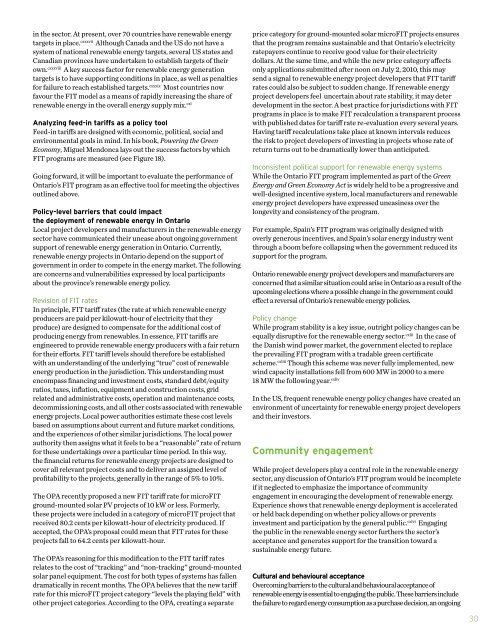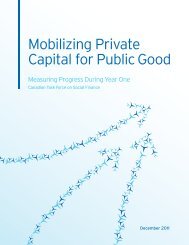Feed-in tariffs Accelerating renewable energy project development ...
Feed-in tariffs Accelerating renewable energy project development ...
Feed-in tariffs Accelerating renewable energy project development ...
Create successful ePaper yourself
Turn your PDF publications into a flip-book with our unique Google optimized e-Paper software.
<strong>in</strong> the sector. At present, over 70 countries have <strong>renewable</strong> <strong>energy</strong><br />
targets <strong>in</strong> place. cxxxvii Although Canada and the US do not have a<br />
system of national <strong>renewable</strong> <strong>energy</strong> targets, several US states and<br />
Canadian prov<strong>in</strong>ces have undertaken to establish targets of their<br />
own. cxxxviii A key success factor for <strong>renewable</strong> <strong>energy</strong> generation<br />
targets is to have support<strong>in</strong>g conditions <strong>in</strong> place, as well as penalties<br />
for failure to reach established targets. cxxxix Most countries now<br />
favour the FIT model as a means of rapidly <strong>in</strong>creas<strong>in</strong>g the share of<br />
<strong>renewable</strong> <strong>energy</strong> <strong>in</strong> the overall <strong>energy</strong> supply mix. cxl<br />
Analyz<strong>in</strong>g feed-<strong>in</strong> <strong>tariffs</strong> as a policy tool<br />
<strong>Feed</strong>-<strong>in</strong> <strong>tariffs</strong> are designed with economic, political, social and<br />
environmental goals <strong>in</strong> m<strong>in</strong>d. In his book, Power<strong>in</strong>g the Green<br />
Economy, Miguel Mendonca lays out the success factors by which<br />
FIT programs are measured (see Figure 18).<br />
Go<strong>in</strong>g forward, it will be important to evaluate the performance of<br />
Ontario’s FIT program as an effective tool for meet<strong>in</strong>g the objectives<br />
outl<strong>in</strong>ed above.<br />
Policy-level barriers that could impact<br />
the deployment of <strong>renewable</strong> <strong>energy</strong> <strong>in</strong> Ontario<br />
Local <strong>project</strong> developers and manufacturers <strong>in</strong> the <strong>renewable</strong> <strong>energy</strong><br />
sector have communicated their unease about ongo<strong>in</strong>g government<br />
support of <strong>renewable</strong> <strong>energy</strong> generation <strong>in</strong> Ontario. Currently,<br />
<strong>renewable</strong> <strong>energy</strong> <strong>project</strong>s <strong>in</strong> Ontario depend on the support of<br />
government <strong>in</strong> order to compete <strong>in</strong> the <strong>energy</strong> market. The follow<strong>in</strong>g<br />
are concerns and vulnerabilities expressed by local participants<br />
about the prov<strong>in</strong>ce’s <strong>renewable</strong> <strong>energy</strong> policy.<br />
Revision of FIT rates<br />
In pr<strong>in</strong>ciple, FIT tariff rates (the rate at which <strong>renewable</strong> <strong>energy</strong><br />
producers are paid per kilowatt-hour of electricity that they<br />
produce) are designed to compensate for the additional cost of<br />
produc<strong>in</strong>g <strong>energy</strong> from <strong>renewable</strong>s. In essence, FIT <strong>tariffs</strong> are<br />
eng<strong>in</strong>eered to provide <strong>renewable</strong> <strong>energy</strong> producers with a fair return<br />
for their efforts. FIT tariff levels should therefore be established<br />
with an understand<strong>in</strong>g of the underly<strong>in</strong>g “true” cost of <strong>renewable</strong><br />
<strong>energy</strong> production <strong>in</strong> the jurisdiction. This understand<strong>in</strong>g must<br />
encompass f<strong>in</strong>anc<strong>in</strong>g and <strong>in</strong>vestment costs, standard debt/equity<br />
ratios, taxes, <strong>in</strong>flation, equipment and construction costs, grid<br />
related and adm<strong>in</strong>istrative costs, operation and ma<strong>in</strong>tenance costs,<br />
decommission<strong>in</strong>g costs, and all other costs associated with <strong>renewable</strong><br />
<strong>energy</strong> <strong>project</strong>s. Local power authorities estimate these cost levels<br />
based on assumptions about current and future market conditions,<br />
and the experiences of other similar jurisdictions. The local power<br />
authority then assigns what it feels to be a “reasonable” rate of return<br />
for these undertak<strong>in</strong>gs over a particular time period. In this way,<br />
the f<strong>in</strong>ancial returns for <strong>renewable</strong> <strong>energy</strong> <strong>project</strong>s are designed to<br />
cover all relevant <strong>project</strong> costs and to deliver an assigned level of<br />
profitability to the <strong>project</strong>s, generally <strong>in</strong> the range of 5% to 10%.<br />
The OPA recently proposed a new FIT tariff rate for microFIT<br />
ground-mounted solar PV <strong>project</strong>s of 10 kW or less. Formerly,<br />
these <strong>project</strong>s were <strong>in</strong>cluded <strong>in</strong> a category of microFIT <strong>project</strong> that<br />
received 80.2 cents per kilowatt-hour of electricity produced. If<br />
accepted, the OPA’s proposal could mean that FIT rates for these<br />
<strong>project</strong>s fall to 64.2 cents per kilowatt-hour.<br />
The OPA’s reason<strong>in</strong>g for this modification to the FIT tariff rates<br />
relates to the cost of “track<strong>in</strong>g” and “non-track<strong>in</strong>g” ground-mounted<br />
solar panel equipment. The cost for both types of systems has fallen<br />
dramatically <strong>in</strong> recent months. The OPA believes that the new tariff<br />
rate for this microFIT <strong>project</strong> category “levels the play<strong>in</strong>g field” with<br />
other <strong>project</strong> categories. Accord<strong>in</strong>g to the OPA, creat<strong>in</strong>g a separate<br />
price category for ground-mounted solar microFIT <strong>project</strong>s ensures<br />
that the program rema<strong>in</strong>s susta<strong>in</strong>able and that Ontario’s electricity<br />
ratepayers cont<strong>in</strong>ue to receive good value for their electricity<br />
dollars. At the same time, and while the new price category affects<br />
only applications submitted after noon on July 2, 2010, this may<br />
send a signal to <strong>renewable</strong> <strong>energy</strong> <strong>project</strong> developers that FIT tariff<br />
rates could also be subject to sudden change. If <strong>renewable</strong> <strong>energy</strong><br />
<strong>project</strong> developers feel uncerta<strong>in</strong> about rate stability, it may deter<br />
<strong>development</strong> <strong>in</strong> the sector. A best practice for jurisdictions with FIT<br />
programs <strong>in</strong> place is to make FIT recalculation a transparent process<br />
with published dates for tariff rate re-evaluation every several years.<br />
Hav<strong>in</strong>g tariff recalculations take place at known <strong>in</strong>tervals reduces<br />
the risk to <strong>project</strong> developers of <strong>in</strong>vest<strong>in</strong>g <strong>in</strong> <strong>project</strong>s whose rate of<br />
return turns out to be dramatically lower than anticipated.<br />
Inconsistent political support for <strong>renewable</strong> <strong>energy</strong> systems<br />
While the Ontario FIT program implemented as part of the Green<br />
Energy and Green Economy Act is widely held to be a progressive and<br />
well-designed <strong>in</strong>centive system, local manufacturers and <strong>renewable</strong><br />
<strong>energy</strong> <strong>project</strong> developers have expressed uneas<strong>in</strong>ess over the<br />
longevity and consistency of the program.<br />
For example, Spa<strong>in</strong>’s FIT program was orig<strong>in</strong>ally designed with<br />
overly generous <strong>in</strong>centives, and Spa<strong>in</strong>’s solar <strong>energy</strong> <strong>in</strong>dustry went<br />
through a boom before collaps<strong>in</strong>g when the government reduced its<br />
support for the program.<br />
Ontario <strong>renewable</strong> <strong>energy</strong> projvect developers and manufacturers are<br />
concerned that a similar situation could arise <strong>in</strong> Ontario as a result of the<br />
upcom<strong>in</strong>g elections where a possible change <strong>in</strong> the government could<br />
effect a reversal of Ontario’s <strong>renewable</strong> <strong>energy</strong> policies.<br />
Policy change<br />
While program stability is a key issue, outright policy changes can be<br />
equally disruptive for the <strong>renewable</strong> <strong>energy</strong> sector. cxlii In the case of<br />
the Danish w<strong>in</strong>d power market, the government elected to replace<br />
the prevail<strong>in</strong>g FIT program with a tradable green certificate<br />
scheme. cxliii Though this scheme was never fully implemented, new<br />
w<strong>in</strong>d capacity <strong>in</strong>stallations fell from 600 MW <strong>in</strong> 2000 to a mere<br />
18 MW the follow<strong>in</strong>g year. cxliv<br />
In the US, frequent <strong>renewable</strong> <strong>energy</strong> policy changes have created an<br />
environment of uncerta<strong>in</strong>ty for <strong>renewable</strong> <strong>energy</strong> <strong>project</strong> developers<br />
and their <strong>in</strong>vestors.<br />
Community engagement<br />
While <strong>project</strong> developers play a central role <strong>in</strong> the <strong>renewable</strong> <strong>energy</strong><br />
sector, any discussion of Ontario’s FIT program would be <strong>in</strong>complete<br />
if it neglected to emphasize the importance of community<br />
engagement <strong>in</strong> encourag<strong>in</strong>g the <strong>development</strong> of <strong>renewable</strong> <strong>energy</strong>.<br />
Experience shows that <strong>renewable</strong> <strong>energy</strong> deployment is accelerated<br />
or held back depend<strong>in</strong>g on whether policy allows or prevents<br />
<strong>in</strong>vestment and participation by the general public. cxlvi Engag<strong>in</strong>g<br />
the public <strong>in</strong> the <strong>renewable</strong> <strong>energy</strong> sector furthers the sector’s<br />
acceptance and generates support for the transition toward a<br />
susta<strong>in</strong>able <strong>energy</strong> future.<br />
Cultural and behavioural acceptance<br />
Overcom<strong>in</strong>g barriers to the cultural and behavioural acceptance of<br />
<strong>renewable</strong> <strong>energy</strong> is essential to engag<strong>in</strong>g the public. These barriers <strong>in</strong>clude<br />
the failure to regard <strong>energy</strong> consumption as a purchase decision, an ongo<strong>in</strong>g<br />
30















